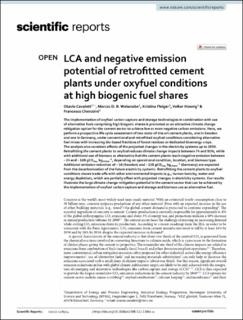| dc.contributor.author | Cavalett, Otávio | |
| dc.contributor.author | Barbosa Watanabe, Marcos Djun | |
| dc.contributor.author | Fleiger, Kristina | |
| dc.contributor.author | Hoenig, Volker | |
| dc.contributor.author | Cherubini, Francesco | |
| dc.date.accessioned | 2023-03-09T11:06:12Z | |
| dc.date.available | 2023-03-09T11:06:12Z | |
| dc.date.created | 2022-08-31T14:28:21Z | |
| dc.date.issued | 2022 | |
| dc.identifier.citation | Scientific Reports. 2022, 12 (1), . | en_US |
| dc.identifier.issn | 2045-2322 | |
| dc.identifier.uri | https://hdl.handle.net/11250/3057301 | |
| dc.description.abstract | The implementation of oxyfuel carbon capture and storage technologies in combination with use of alternative fuels comprising high biogenic shares is promoted as an attractive climate change mitigation option for the cement sector to achieve low or even negative carbon emissions. Here, we perform a prospective life cycle assessment of two state-of-the art cement plants, one in Sweden and one in Germany, under conventional and retrofitted oxyfuel conditions considering alternative fuel mixes with increasing bio-based fractions of forest residues or dedicated bioenergy crops. The analysis also considers effects of the projected changes in the electricity systems up to 2050. Retrofitting the cement plants to oxyfuel reduces climate change impacts between 74 and 91%, while with additional use of biomass as alternative fuel the cement plants reach negative emission between − 24 and − 169 gCO2eq. kgclinker−1, depending on operational condition, location, and biomass type. Additional emission reduction of − 10 (Sweden) and − 128 gCO2eq. kgclinker−1 (Germany) are expected from the decarbonization of the future electricity systems. Retrofitting the cement plants to oxyfuel conditions shows trade-offs with other environmental impacts (e.g., human toxicity, water and energy depletion), which are partially offset with projected changes in electricity systems. Our results illustrate the large climate change mitigation potential in the cement sector that can be achieved by the implementation of oxyfuel carbon capture and storage and biomass use as alternative fuel. | en_US |
| dc.language.iso | eng | en_US |
| dc.publisher | Springer Nature | en_US |
| dc.rights | Navngivelse 4.0 Internasjonal | * |
| dc.rights.uri | http://creativecommons.org/licenses/by/4.0/deed.no | * |
| dc.title | LCA and negative emission potential of retrofitted cement plants under oxyfuel conditions at high biogenic fuel shares | en_US |
| dc.title.alternative | LCA and negative emission potential of retrofitted cement plants under oxyfuel conditions at high biogenic fuel shares | en_US |
| dc.type | Peer reviewed | en_US |
| dc.type | Journal article | en_US |
| dc.description.version | publishedVersion | en_US |
| dc.source.pagenumber | 14 | en_US |
| dc.source.volume | 12 | en_US |
| dc.source.journal | Scientific Reports | en_US |
| dc.source.issue | 1 | en_US |
| dc.identifier.doi | 10.1038/s41598-022-13064-w | |
| dc.identifier.cristin | 2047620 | |
| cristin.ispublished | true | |
| cristin.fulltext | original | |
| cristin.qualitycode | 1 | |

